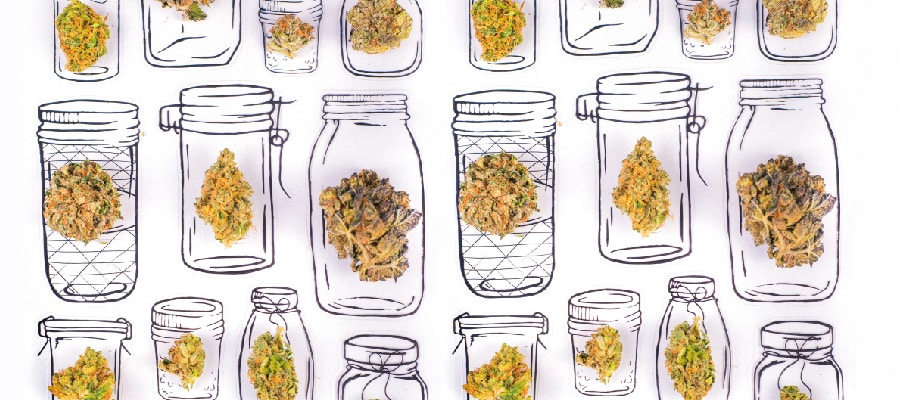6 Common Cannabis Packaging Issues – and How to Avoid Them

Cannabis Packaging Issues Today
The cannabis packaging industry, as a whole, is facing unprecedented packaging demands. Rarely before has a product had so many uses or come in so many packaging formats. This creates several roadblocks when it comes to developing child-resistant packaging, catering to consumer needs and creating a safer market as the industry grows.
Here are six common cannabis packaging issues cannabis cultivators, manufacturers, and dispensaries are facing in packaging their products and some insight on solutions.
Child-Resistant Cannabis Packaging and Sustainability Collide
Cannabis packaging must be strong enough to be child-resistant as required by legislation but balancing safety with sustainability is difficult.
Plastic is frequently used for packaging for its strength, but it is not as environmentally friendly as some other materials. Packaging choices for the cannabis industry are limited and finding packaging with a low carbon footprint can be difficult.
Multi-use packaging deals with a problem that currently exists of users just pulling products out of an exit bag and tossing it. If packaging is multi-use, product is kept in it and remains child-resistant at home until the product is finished.
Companies should be looking for multi-use packaging that can accomplish many goals – reduce waste, avoid unnecessary excess and reduce costs.
As the industry continues to mature, companies are playing with many different types of materials and using new technologies to create better materials. More child-resistant, sustainable packaging will emerge over time.
Labeling Versus Branding
State regulations may require opaque or clear packaging and warning labels may need to be a specific size or appear in a specific location. Regulations also change all the time. Including branding in addition to staying abreast of regulations and complying with them can pose cannabis packaging issues.
Companies must meet labeling requirements. Packaging should be designed to allow for correct labeling and personal branding. Some companies provide packaging with a flatter front and more space for labeling so having to use legal language does not come at the expense of branding. This is very important as packaging is integral to branding.
Shelf Appeal
Dispensaries are not like grocery stores or liquor stores where there’s plenty of retail space for brands to display their products. Companies have to fight for shelf space, be it on walls behind budtenders in a dispensary or inside of a display unit.
Even when companies get display space, it can be difficult for the packaging to stand out from the competition. Companies may use additional packaging to try and stand out – they may start out with a pop-top package and then put that into another package to give them a presence on the shelf.
Creativity, or Lack Thereof
Creativity of manufacturers may suffer due to the limited packaging shapes currently available. Cannabis companies should be looking for packaging providers who work with product developers to create innovative packaging, exploring the use of new materials and packaging formats.
New products and changing legislation means cannabis packaging issues and an industry screaming out for more innovation. New products require different types of packaging, capable of providing moisture and gas barriers. Savvy equipment suppliers need to start designing machines that could help to address cannabis-specific packaging challenges.
Finding a Trustworthy Supplier
When looking for cannabis packaging providers, cannabis companies should not just look for innovative packaging. It’s important to deal with trustworthy suppliers who can deliver products on time. Flexible delivery and customization options are important. Suppliers should work together with brands to find out what works best for them.
Catering to the Consumer
Cannabis consumers want packaging that’s easy to use and sustainable, so suppliers need to cater to these needs. Packaging must be challenging enough to stop children from opening it but easy enough for the elderly to access. A balance is required when designing it.
Companies need to address child-resistance but not in a way that irritates and annoys their customers. When it comes to packaging, cannabis brands must think about functionality as well as appearance. Other consumer concerns are shelf-life and smell, and packaging materials should address these concerns.
Some cannabis consumers don’t want to smell like cannabis and prefer to be discreet whereas others don’t mind. Additionally, some consume cannabis recreationally, and others are patients with medical problems. The type of packaging used has to consider this.
Concluding Thoughts
Various problems are evident in the cannabis packaging industry. Packaging must be child-resistant and be recyclable or non-wasteful at the same time. Certain information must be seen on the label, and this means achieving a balance between what’s required and branding.
Making packaging stand out from the competition requires creativity and innovation. Finding trustworthy suppliers and catering to the varying needs of consumers are other challenges. As the industry grows, more attention is being devoted to cannabis packaging, and creative solutions are emerging to address the most common problems.
Content Contributor: Green Rush Packaging
Talk to industry leaders and learn more about cannabis packaging problems at a CannaCon conference near you.
